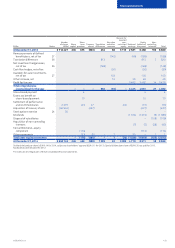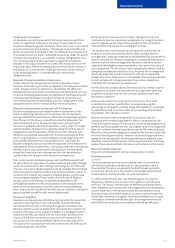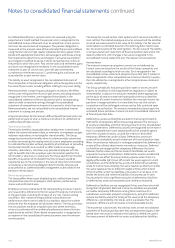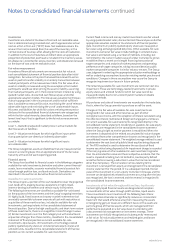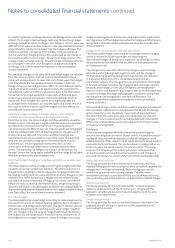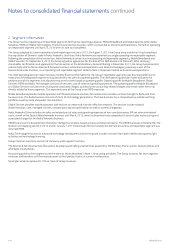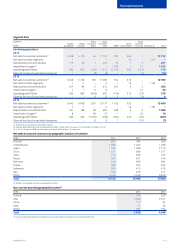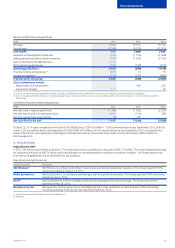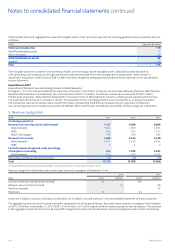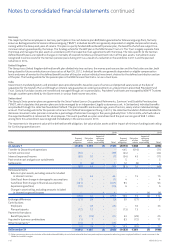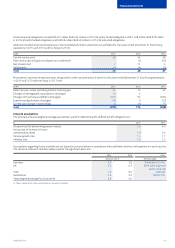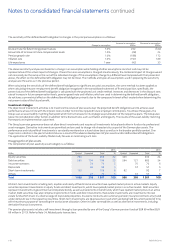Nokia 2014 Annual Report Download - page 140
Download and view the complete annual report
Please find page 140 of the 2014 Nokia annual report below. You can navigate through the pages in the report by either clicking on the pages listed below, or by using the keyword search tool below to find specific information within the annual report.138 NOKIA IN 2014
Carrying value of the HERE cash-generating unit
The recoverable amount of the HERE CGU is determined using the fair
value less costs of disposal method. Estimation and judgment are
required in determining the components of the recoverable amount
calculation, including the discount rate, the terminal growth rate,
estimated revenue growth rates, prot margins, costs of disposal and
the cost level of operational and capital investment. The discount rate
reects current assessments of the time value of money, relevant
market risk premiums, and industry comparisons. Risk premiums
reect risks and uncertainties for which the future cash ow estimates
have not been adjusted. Terminal values are based on the expected
life of products and forecasted life cycle, and forecasted cash ows
over that period. In 2014, the Group recorded an impairment loss of
EUR 1 209 million to reduce the carrying amount of the HERE CGU to
its recoverable amount. The remaining carrying amount of the HERE
goodwill is EUR 2 273 million. As the carrying amount of the HERE CGU
has been written down to its recoverable amount, any increase in the
discount rate, any decrease in the terminal growth rate, or any material
change in other valuation assumptions could result in further
impairment. Refer to Note 10, Impairment.
Allowances for doubtful accounts
Allowances for doubtful accounts are recognized for estimated losses
resulting from customers’ inability to meet payment obligations.
Estimation and judgment are required in determining the value of
allowances for doubtful accounts at each statement of nancial
position date. Management specically analyzes account receivables
and historical bad debt; customer concentrations; customer
creditworthiness; past due balances; current economic trends; and
changes in customer payment terms when determining allowances
for doubtful accounts. Additional allowances may be required in future
periods if nancial positions of customers deteriorate, reducing their
ability to meet payment obligations. Based on these estimates and
assumptions, allowances for doubtful accounts are EUR 103 million
(EUR 124 million in 2013 for Continuing operations), representing 3%
of accounts receivable (4% in 2013). Refer to Note 22, Allowances for
doubtful accounts.
Allowances for excess and obsolete inventory
Allowances for excess and obsolete inventory are recognized for
excess amounts, obsolescence and declines in net realizable value
below cost. Estimation and judgment are required in determining the
value of the allowance for excess and obsolete inventory at each
statement of nancial position date. Management specically analyzes
estimates for future demand for products when determining
allowances for excess and obsolete inventory. Changes in these
estimates could result in revisions to the valuation of inventory in
future periods. Based on these estimates and assumptions,
allowances for excess and obsolete inventory are EUR 204 million
(EUR 178 million in 2013 for Continuing operations), representing
14% of inventory (18% in 2013). Refer to Note 21, Inventories.
Fair value of derivatives and other nancial instruments
The fair value of derivatives and other nancial instruments that
are not traded in an active market such as unlisted equities are
determined using valuation techniques. Estimation and judgment
are required in selecting an appropriate valuation technique and in
determining the underlying assumptions. Where quoted market
prices are not available for unlisted shares, the fair value is based on
a number of factors including, but not limited to, the current market
value of similar instruments; prices established from recent arm’s
length transactions; and/or analysis of market prospects and
operating performance of target companies with reference to public
market comparable companies in similar industry sectors. Changes in
these estimates could result in impairments or losses in future
periods. Based on these estimates and assumptions, the fair value of
derivatives and other nancial instruments that are not traded in an
active market, using non-observable data (level 3 of the fair value
hierarchy), is EUR 556 million (EUR 429 million in 2013 for Continuing
operations), representing 9% of total nancial assets measured at fair
value on a recurring basis (7% in 2013). Refer to Note 19, Fair value
of nancial instruments.
Provisions
Provisions are recognized when the Group has a present legal or
constructive obligation as a result of past events, it is probable that
an outow of resources will be required to settle the obligation, and
a reliable estimate of the amount can be made. At times, judgment is
required in determining whether the Group has a present obligation;
estimation is required in determining the value of the obligation.
Whilst provisions are based on the best estimate of unavoidable costs,
management may be required to make a number of assumptions
surrounding the amount and likelihood of outow of economic
resources, and the timing of payment. Changes in estimates of
timing or amounts of costs to be incurred may become necessary
as time passes and/or more accurate information becomes available.
Based on these estimates and assumptions, provisions amount to
EUR 873 million (EUR 922 million in 2013 for Continuing operations).
Refer to Note 28, Provisions.
Legal contingencies
Legal proceedings covering a wide range of matters are pending or
threatened in various jurisdictions. Provisions are recognized for
pending litigation when it is apparent that an unfavorable outcome is
probable and a best estimate of unavoidable costs can be reasonably
estimated. Due to the inherently uncertain nature of litigation, the
ultimate outcome or actual cost of settlement may vary materially
from estimates. Refer to Note 28, Provisions.
New accounting pronouncements under IFRS
The Group will adopt the following new and revised standards,
amendments and interpretations to existing standards issued by
the IASB that are expected to be relevant to its operations and
nancial position:
IFRS 9, Financial Instruments, was issued in July 2014 and replaces IAS
39, Financial Instruments: Recognition and Measurement. The Group
will adopt the standard at the latest on the eective date of January 1,
2018. The adoption of the new standard will impact the classication
and measurement of the Group’s nancial assets and introduces a new
hedge accounting model. The Group is currently assessing the impact
of IFRS 9.
IFRS 15, Revenue from Contracts with Customers, was issued in May
2014 and establishes a new ve-step model that will apply to revenue
arising from contracts with customers. Under IFRS 15, revenue is
recognized to reect the transfer of promised goods and services to
customers for amounts that reect the consideration to which an
entity expects to be entitled in exchange for those goods or services
to a customer. The adoption of the new standard is likely to have an
impact on the way revenue is being recognized. Though permitted,
the Group is not expecting to early adopt the standard. The full impact
of IFRS 15 is currently being assessed.
The amendments and improvements described below will be
adopted on January 1, 2015 and they are not expected to have
a material impact on the nancial condition and the results of
operations of the Group.
Notes to consolidated nancial statements continued



